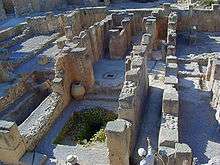Byrsa

Byrsa was a walled citadel above the Phoenician harbour in ancient Carthage, Tunisia. It was also the name of the hill it rested on.
In Virgil's account of Dido's founding of Carthage, when Dido and her party were encamped at Byrsa, the local Berber chieftain offered them as much land as could be covered with a single oxhide. Therefore, Dido cut an oxhide into tiny strips and set them on the ground end to end until she had completely encircled the hilltop of Byrsa (Greek βύρσα meaning "oxhide").
The citadel dominated the city below and formed the principal military installation of Carthage. It was besieged by Scipio Aemilianus Africanus in the Third Punic War and was defeated and destroyed in 146 BC.
Saint Louis Cathedral was built on Byrsa Hill starting in 1884. Today, it serves as a cultural center.[1]
In 1994, the body of an ancient Carthaginian individual was excavated from a 2500-year-old Punic tomb in Byrsa Hill. In 2016, he was found to belong to the rare U5b2c1 maternal haplogroup. The Young Man of Byrsa specimen dates from the late 6th century BCE, and his lineage is believed to represent early gene flow from Iberia to the Maghreb.[2]
Today, Byrsa Hill is part of the archaeological site of Carthage. In addition to a cathedral monument, the Carthage National Museum was erected atop it.
References
| Wikimedia Commons has media related to Byrsa. |
- ↑ "Cathedral, Carthage, Tunisia". World Digital Library. Retrieved 2 March 2013.
- ↑ Matisoo-Smith EA, Gosling AL, Boocock J, Kardailsky O, Kurumilian Y, Roudesli-Chebbi S et al. (May 25, 2016). "A European Mitochondrial Haplotype Identified in Ancient Phoenician Remains from Carthage, North Africa" (PDF). PLoS ONE. 11 (5). doi:10.1371/journal.pone.0155046. Retrieved 26 May 2016.
Coordinates: 36°51′08″N 10°19′26″E / 36.85222°N 10.32389°E